For an introduction, see the Kayarchy chapter Sea Kayak Construction Methods (5) Skin on Frame.
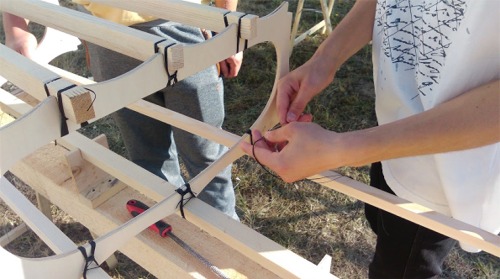 |
Hull, deck and cockpit
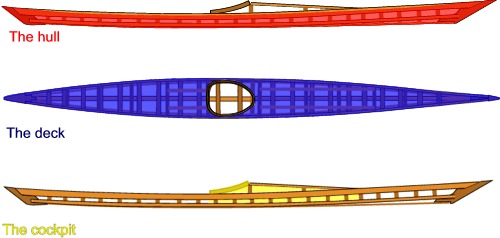
The deck structure
The first element of a skin-on-frame kayak is the deck (in red below). This is like a wooden ladder.
The ladder sides are the 'gunwales', and the rungs are the deck beams and the 'masik' (in blue).
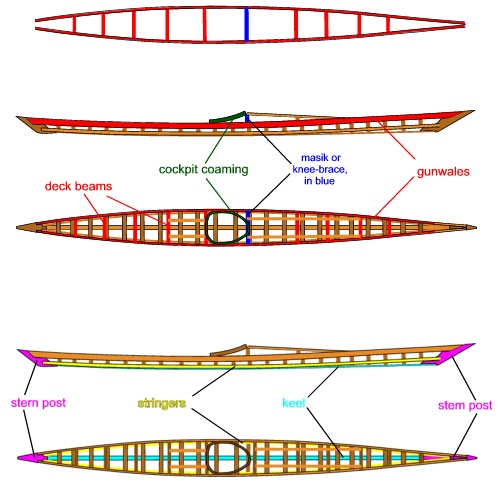
This photo by Richard Best shows the gunwales, deck beams and masik for a Caribou kayak:
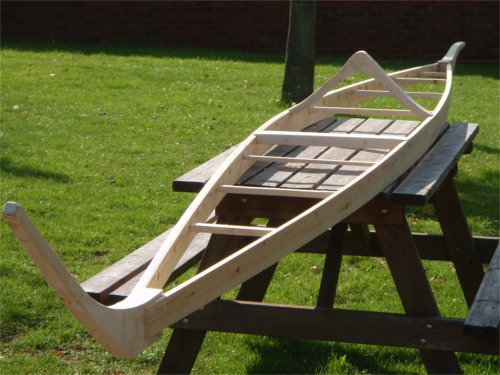
The hull structure
The hull structure, which is inserted below the deck structure, is made of 'ribs' and 'stringers'.
The ribs go from one side of the kayak to the other. They define the cross-sectional shape of the hull. Traditionally they are long, thin, flexible pieces of wood. They start off straight, they are steamed until they're soft, and then they're bent into a U-shape. By acting as springs, they can make the whole structure more resilient.
Not all builders use steam-bent ribs. Some prefer to define the cross-section with panels cut from sheets of plywood ("sawn frames") shaped something like the graphic below. The photo at the top of this page shows a SOF kayak with sawn frames. If you're building a 17-foot Greenland kayak the traditional way, you might need 22 steam-bent ribs, 9 deck beams and 1 masik. If you prefer sawn frames, you'll only need 6 frames to replace all 32 of these. Building with sawn frames take more design work before you start building your boat, but once the design is done, it's much faster to build with sawn frames. Also, the frames define the cross-sectional shape of the boat more accurately.
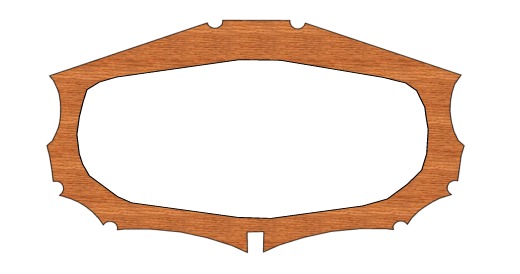
However, it's more authentic to use steam-bent ribs, and it may also produce a tougher boat. You can compare it to a wicker basket, light but strong, good for carrying heavy loads, and if you turn it upside down you can stand on it. It will creak a bit and it may bend, but it will support your weight and it won’t shatter. This toughness is the reason why hot-air balloon passengers ride in a big basket, woven from cane or wicker. Balloon companies tried baskets made of Kevlar and epoxy but they just weren’t tough enough. Balloons sometimes come down hard. One bad landing shatters a Kevlar basket but a wicker basket just creaks and carries on.
Cross-section through the middle of a 17’ Greenland kayak.
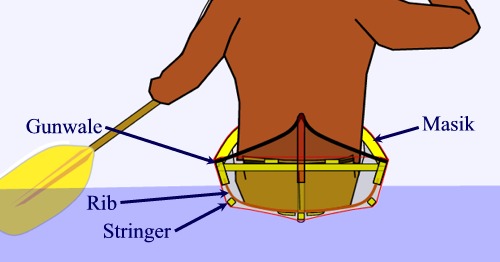
Of course, we don't want the ribs to show through the skin or your boat will look like a starved dog. That's where the stringers come in. They go almost the full length of the kayak. They streamline the hull shape, and they stop the skin from touching the ribs so water flows smoothly along the length of the hull.
A 28-foot rowing umiak:

Except for kayaks, canoes and curraghs, most skin-on-frame boats are based on a very strong keel which goes from one end to the other at the bottom; a vertical stem post at the front; a vertical stern post at the back; a pair of long, curved gunwales which are the top edge of the hull; and a number of thwarts going from side to side, which are basically the seats. These are the most solid pieces of wood. The rest of the frame is a basket-like structure made up of stringers going from one end of the boat to the other, and flexible ribs that go from side to side.
Cross-section through the middle of a 28’ rowing umiak.
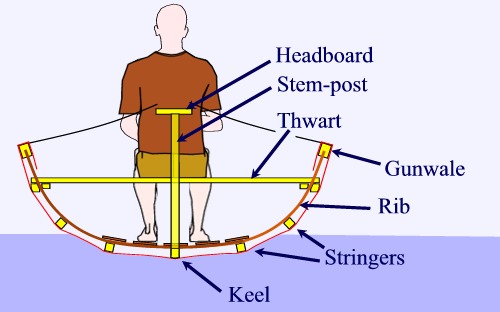
All these pieces of wood are mostly lashed together using some sort of thin synthetic cord or line, without screws or glue. This gives flexibility, which may or may not be good for performance at sea, but is great if you’re rammed by another boat, a wave shoves your boat up a concrete slipway, or you come alongside a dock with a bit too much enthusiasm.
Go to:
Contents page for this article
Go to next page for:
• Getting ready to build